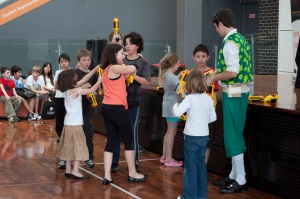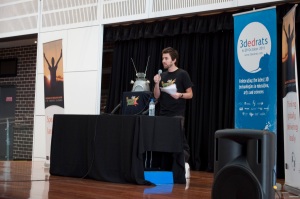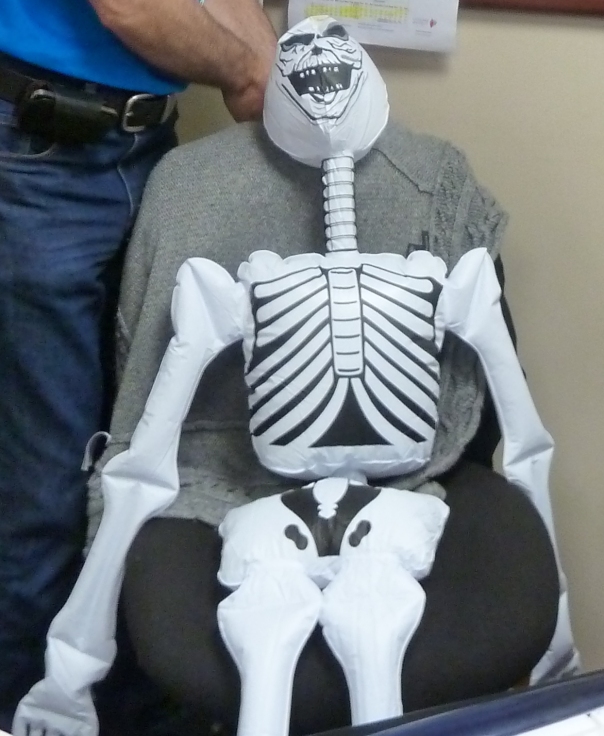Game On! Well it certainly was Saturday 29 October at Macquarie Uni. The kids came, saw and conquered many awesome events on the day.
Indie game developers came to showcase their games. They answered questions about things like the gaming industry and what it is like starting your own development company. It gave kids a rare opportunity to hear the stories from the real, grass roots level people in the Games Industry. Kids were observed sitting with these developers asking questions playing their games and getting an understanding of what happens behind the scenes. In the same area kids with parents were seen trying to out-do one another in the Retro Gaming Hub. One dad kept coming back several times to the Space Invaders pod to see if he still had the high score lol! “Yep, still got it” he muttered as he surreptitiously cut through the expectant crowd.

Retro gaming in action!
Zombies!!!!! Who wouldn’t want to be a zombie or have the chance to nerf one? The Live Action Zombie Nerf Tag Game drew the crowds. The sizzle of nerf bullets and groans of the pained, walking dead got the heart racing from even the position of the innocent spectators. Definitely a must for all gamers and even noobs. Fun for all ages, even the 6 year old girl who had to show her older brother how to reload the nerf gun and cock the firing pin. Her delicate little voice saying “You put the bullet in here and you pull the hammer back here, see.” was heart warming heart.

Zombies - looking for brains!

Nerf gun distribution - to the humans!
Let’s not forget the Massively Minecraft rooms. Experienced miners, small miners, big miners and soon to be miners all lent forward in build pose thoroughly immersed in digging building and blowing stuff up. Well, who doesn’t like the last bit? Cudos to the Massively Minecraft mob for providing a safe and educational environment for all involved. Success could be best gauged by the amount of children being dragged from the rooms just before closing by their parents kicking and screaming “Five more miiinaaaarts! Come on pleeeeease.” If only school was this addictive.

The crew from Good Game Spawn Point descend on miners at MacICT

Mining in Massively Minecraft was a huge attraction
There was game designing speed challenges using Microsoft’s Kodu Game Lab with the chance to win awesome prizes on the day. Everyone got in on that act. Even some, what looked to be, ‘experienced gamers’ were in there showing a dab hand at creating their best efforts at Kodu Battlefield and Kodu-COD.

Girls competing in the Kodu rapid prototyping speed challenge
The info session were well attended by parents, teachers, academics and other ring ins.The teachers kicked it off with their session, “We Play, We Design, We Learn” Thanks to Alice Leung, Joanne Cologan, Peter Robson and Simon Hutchison were happy to share their experiences around games and game design in their classrooms. They were followed by two boys from Gordon East Public School who gave an excellent presentation about what they have learnt from designing games in their classroom.
Joanne Cologon “We play, we design, we learn” Alice Leung “We play, we design, we learn” Peter Robson “We play, we design, we learn” Simon Hutchison and the students of Gordon East PS – Game Design Project
The teachers were followed by parent and Massively Minecraft co-founder, Dean Groom who gave people tips on managing children’s gaming habits.
Dean Groom “Managing children’s gaming habits”
After Dean, Professor James Dalziel and lecturer Kate Highfield from Macquarie University gave a very informative session titled, “inside the head of a gamer – what is happening when we play and design games.”
Prof James Dalziel “Inside the head of a gamer” Kate Highfield “Inside the head of a gamer”
The final info session was delivered by Dr Rowan Tulloch from Macquarie Uni’s new Interactive Media Institute on “So you want to be a game designer? How to break into the video game industry?” Rowan spent some time after his session answering questions from parents of gamers and teachers about the video game design industry.
Dr Rowan Tulloch “So you want to develop video games?”
Gaming advocate, journalist and all round great guy, Goose, and the data analysing robot for the ruthless, extermination of noobs, DARREN from Good Game – Spawn Point made a presentation to a mass of spawnlings and noobs in the MQ Uni Atrium. Goose and DARREN presented some interesting information about games and what makes a good game as well as providing an interesting Q&A session at the end of their presentation. The kids loved it. It was like a press conference on the outbreak of SARS when a kid from the audience stood and asked “DARREN, how many noobs are there in the world?” Of course his reply was serious, deliberate and speedy when he answered “After considering all the variables and the population of the world currently I estimate there are approximately four billion noobs in the world at this moment.” Priceless.

Goose and DARREN from Good Game Spawn Point wow the crowd!

Budding video game journalists in the crowd

Goose and DARREN entertained the young and young at heart!
Wow! You might say, but that’s not all. Kids also participated in an Xbox Kinect – Dance Central 2 competition and a huge group session of Michael Jackson – The Experience. Around fifty kids were all doing the moves from the famous ‘Thriller’ track as they rotated in front of the Kinect scoring points and moon walking better than the late MJ himself. And what a climax, a dance off between the final two Dance Central top scorers for a Lenovo Idea Pad. A primary school girl versus a high school boy. Seem unfair? We all learned size means nothing on a Kinect playing field. The lead must have changed three times as they sky pumped and twirled their way through the complicated choreography. I have to admit, I had goosebumps in the final moments watching as the youngest competitor came back with vengeance to take the crown.

Gordon East PS students having fun with Kinect Dance Central 2
To top it all off, the gurus of game, Goose and DARREN presented the prizes from the various competitions run on the day rewarding the spawnlings with their just desserts. As a gamer, you can’t get better than that.
Good Game Spawn Point Feature Story: Game On
The awesome team from MacICT who organised the festival were thoroughly exhausted by the end of the day, but were oh so happy and the vibe, excitement and feedback received from so many at the festival.

This is how the MacICT staff felt at the end of the day - notice, we still have a smile on our face.














